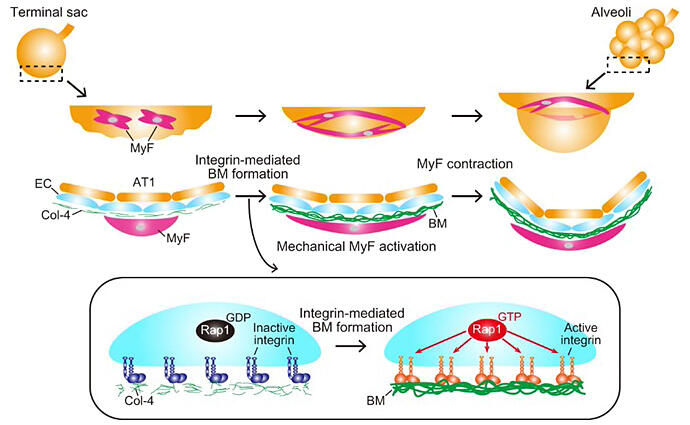The alveolus, the lung tissue responsible for oxygen and carbon dioxide exchange during breathing, is a small, pouch-like structure at the ends of the bronchi, and several hundred million of these are contained in the lungs. In severe lung diseases such as chronic obstructive pulmonary disease (COPD), the alveoli may be destroyed, resulting in death from breathing difficulties. However, until now, no method has been established to regenerate destroyed alveoli.
Alveolar myofibroblasts have a strong contractile force and are involved in alveoli formation. Based on previous findings, a model has been proposed in which alveolar myofibroblasts wrap around the pouch-like terminal sac and contract to form a nodule, forming an alveolus. A research group led by Professor Haruko Takano and Professor Shigetomo Fukuhara of the Department of Molecular Pathophysiology of the Nippon Medical School Institute of Advanced Medical Science focused on vascular endothelial cells, which constitute the alveoli along with other cells and are responsible for oxygen and carbon dioxide (CO2) gas exchange. They found that when the gene for Rap1, an intracellular signaling molecule, was destroyed in vascular endothelial cells in mice, the formation of lung alveoli was suppressed.
These results revealed that vascular endothelial cells form a basement membrane by activating integrin, a cell adhesion molecule in a Rap1-dependent manner to accumulate type IV collagen and that this basement membrane acts as a scaffold for myofibroblasts, inducing contraction of these cells and promoting alveolar formation.
The results of this research may be applicable to the development of alveolar regeneration technology, which in turn could lead to new treatments for COPD and infectious respiratory diseases. Moreover, alveolar organoids, which mimic organs in a test tube, are expected to have even greater functionality when combined with vascular endothelial cells, which have not been included previously, thereby contributing to the clarification of diseases and therapeutic development.





